The 2023 Northern Lights photographer of the year
Photographing the Northern Lights is a breathtaking experience.
There aren’t many events as moving as seeing the Aurora Borealis paint the sky with hues of green and violet. Under this awe-inspiring phenomenon, each location becomes magical when the Aurora shines across the night sky.
We are getting close to the solar maximum of our current solar cycle, which means Northern Lights displays at lower latitudes and from original places where the Aurora hasn’t been photographed before. To help you find inspiration for planning and executing your images, in this 6th edition of our Northern Lights Photographer of the Year, we present the 25 best Northern Lights images captured around the world.
Buckle up because this trip is going to take you from the remote boreal forests of the Arctic to the far landscapes of Australia and New Zealand, passing by spectacular lakes, mountains, and beaches along the way…always with the Northern Lights dancing in the sky.
“Storm Over Sukakpak” – Nickolas Warner

“Storm Over Sukakpak” – Nickolas Warner
- Alaska, USA
Located approximately 70 miles North of the Arctic Circle, Sukakpak Mountain is one of the most beautiful peaks in the Brooks Mountain Range. While I have photographed the Northern Lights in this area on numerous occasions, the most photogenic angle typically faces south, making it a bit challenging for auroras to align with the mountain.
That night, there was an expectation of an X-Class flare hitting, so I knew we needed to head somewhere great. We took our chances and decided to drive an hour north from our accommodation to capture Sukakpak Mountain in all its glory.
It’s very tempting to pull over and shoot where you are standing when the aurora is blazing above your head. When we got there, the sky exploded with more energy than I’ve seen in more than a decade of photographing the Aurora. Attempts to capture Northern Lights that intense resulted in a blurry mess. Instead, we ignored the cameras and stared up in awe as to not miss the light show.
It was only once things slowed down that I captured this panorama.
Sky: 3.2 Seconds, F/2.8, ISO 2500, 3 Frames
Foreground: 8 Seconds, F/5.6, ISO 800, 3 Frames
- Sony A7RIV
- Sigma 14-24mm f2.8
- Leofoto tripod
“The Arctic Dance” – Vincent Beudez
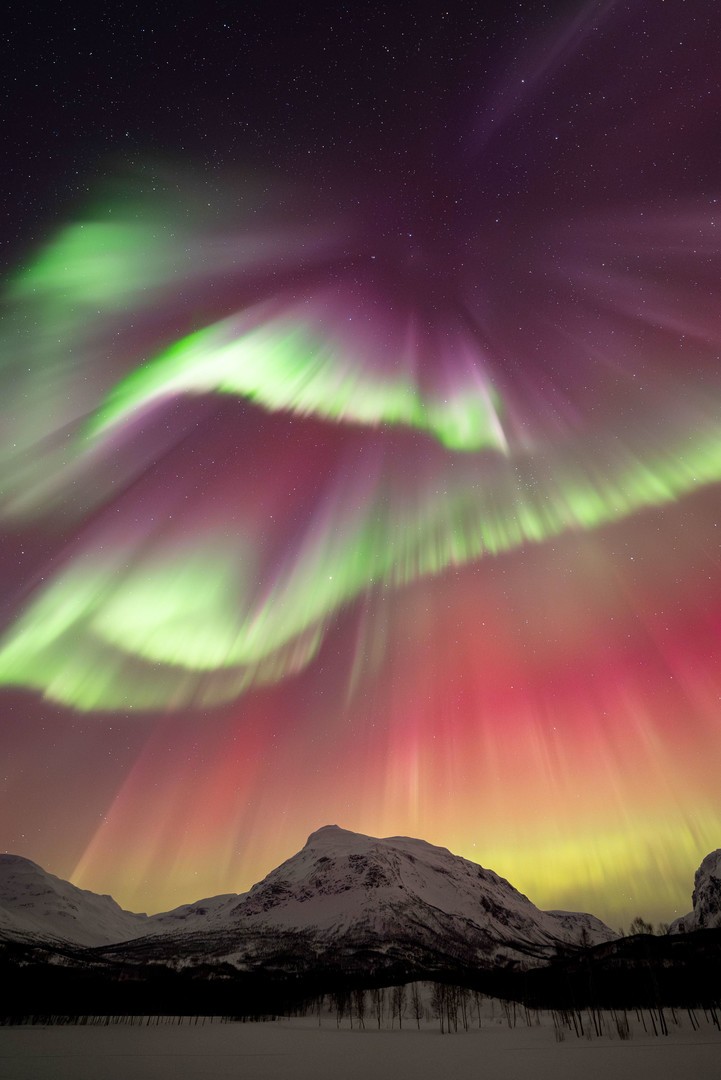
“The Arctic Dance” – Vincent Beudez
- Tromso, Norway
As Northern Lights photographers, this is the moment we live for, the strongest solar storm of the year. That particular night, the Northern Lights were so strong that they were even visible from France, my home country.
At that time, I was in Northern Norway, which meant I could see an incredible show even facing south. I was able to see the most colorful Northern Lights I’ve ever witnessed. Being a night photographer as well, I’m not only looking for the Northern Lights, but I chase shapes within a perfect environment, to create the perfect composition.
It’s hard to put into words the feeling when I saw this red curtain surrounded by dancing lights.
“Lost Who I Want To Be” – Jordan McInally
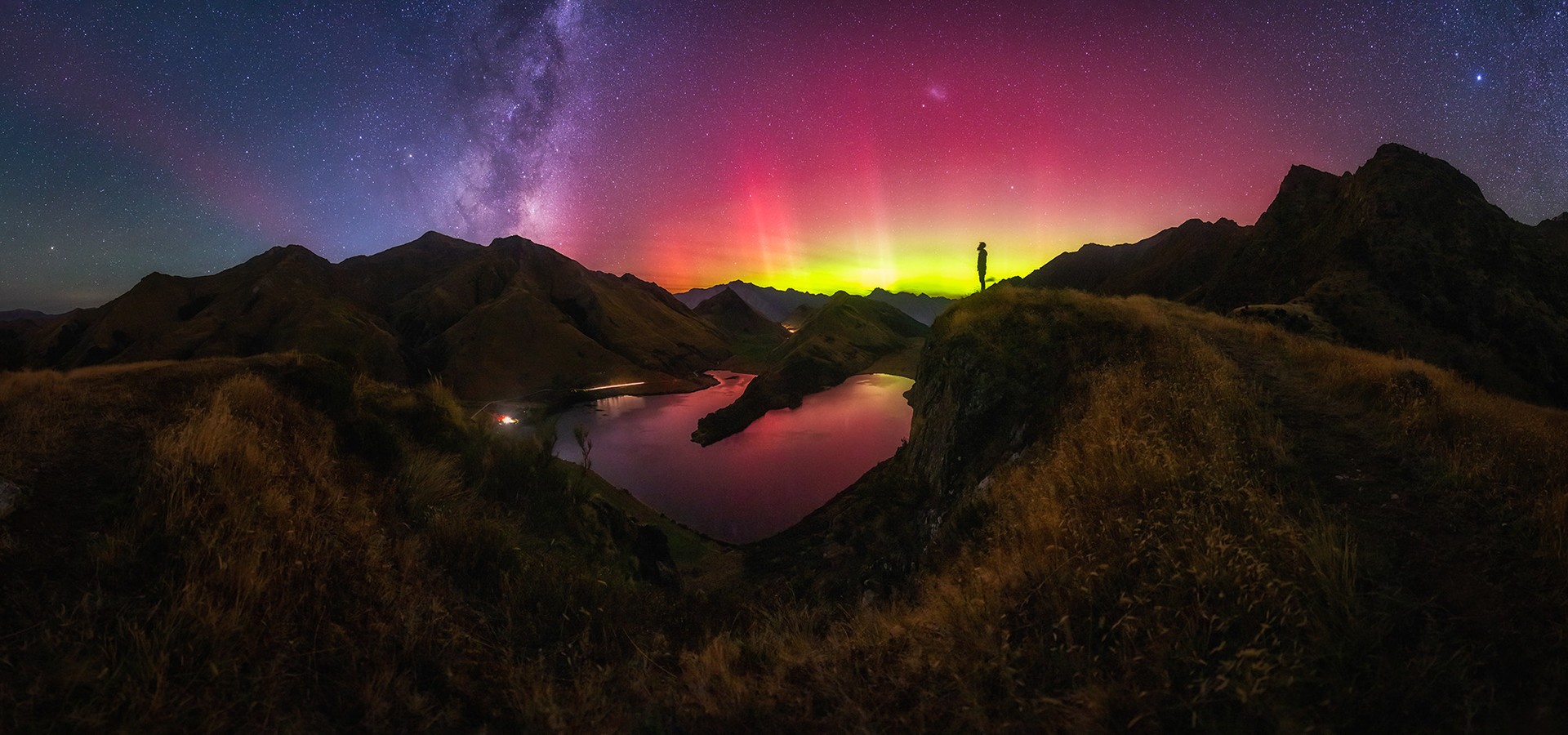
“”Lost Who I Want To Be” – Jordan McInally
- Moke Lake, New Zealand
I was pretty lucky this night to have a few friends message me a heads up that a big Aurora Australis was forecast, so I had just enough time to rush to this local spot with a painfully steep ascent, watching beams start to dance across the horizon as the sunlight was fading!
I spent around 5 hours up here and had this whole ridge to myself, shooting over 300 frames of all manner of beams and colours as the show was constantly changing!
ISO10,000 f/2.8 16mm 20sec
8 portrait shot panorama
“Red Alert” – William Preite
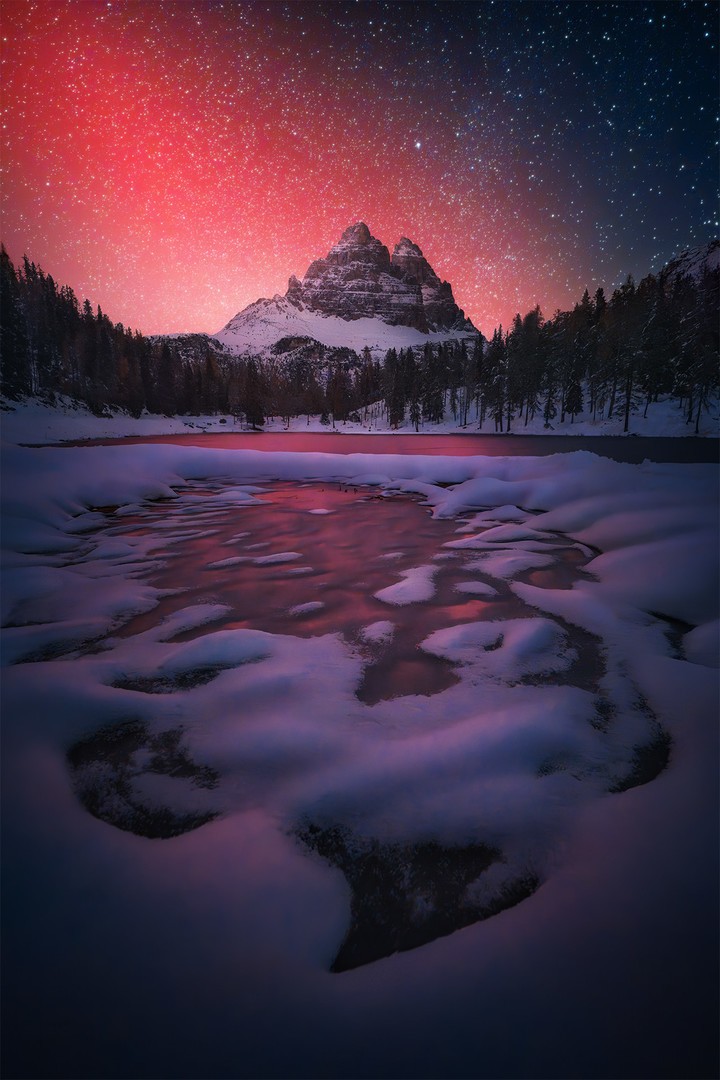
“Red Alert” – William Preite
- Dolomites, Italy
I was in the right place and at the right time, during my usual autumn tour in Italy’s Dolomites.
That Sunday, I never thought I would witness such a rare spectacle. There was a strong magnetic storm in the north, which partly spread to Southern Europe. Scientists call this event SAR (Stable Auroral Red arcs) which is even more rare than the Aurora itself.
“Infinity” – Giulio Cobianchi
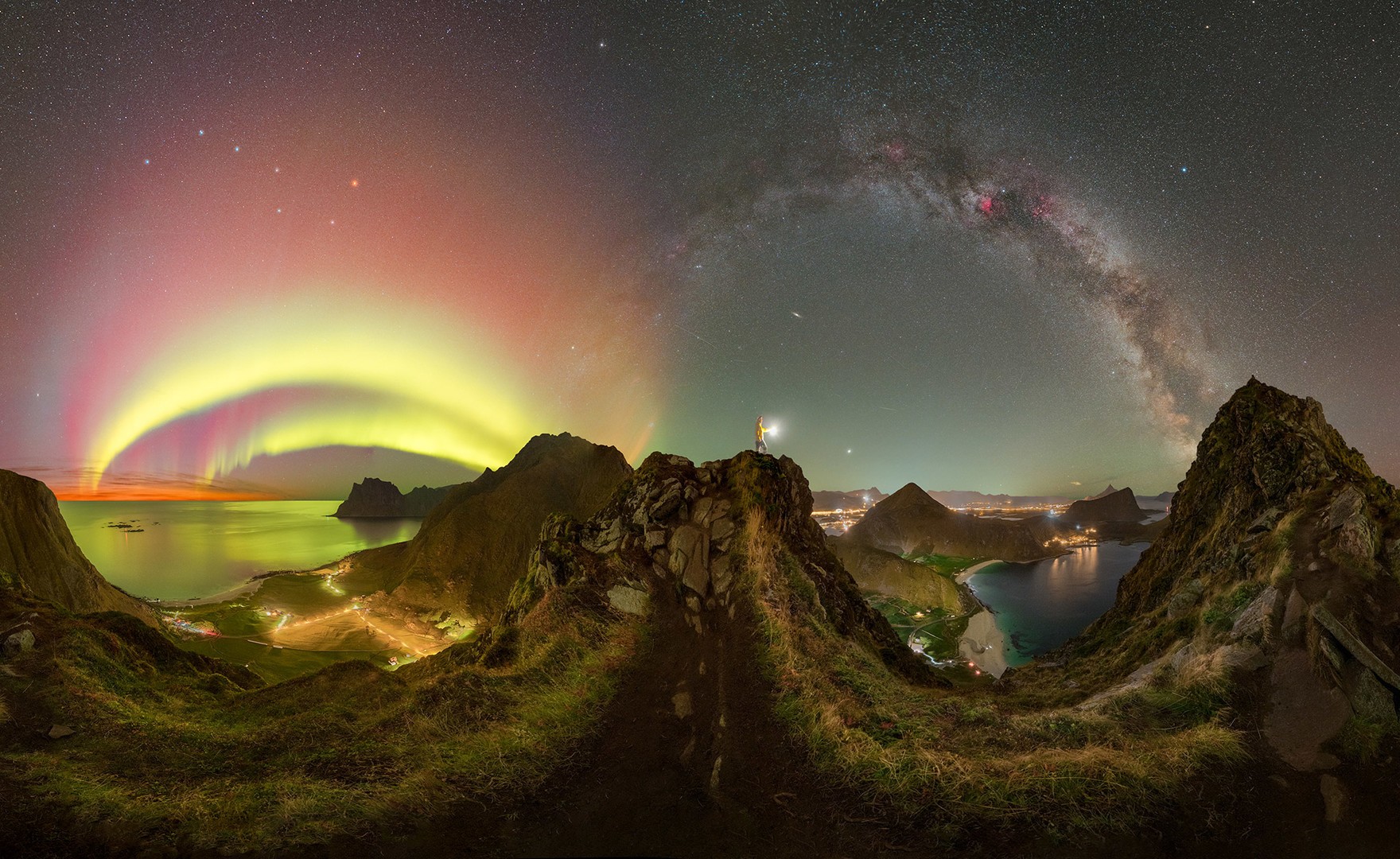
“Infinity” – Giulio Cobianchi
- Lofoten Islands, Norway
In the last few years in Lofoten, I’ve captured several “double arc” panoramas, but each time is a complex endeavor as many factors must align, and in the Arctic, it’s no easy feat. The aurora needs to be visible only to the north, it has to be a moonless night, and clear skies are essential. Additionally, the conditions must allow you to reach the peaks without excessive risk.
Picture yourself at the summit of a mountain, positioned between the Northern Lights and the Milky Way, aware that this ephemeral moment may last only seconds or minutes.
Being focus on such a situation, and not wasting the moment, is challenging. The planning involved in capturing this type of photo brings immense satisfaction, watching the elements of this intricate puzzle slowly converge. This photography style has become one of my favorites.
Panoramic of 30 shots in 3 horizontal rows with the camera in portrait mode.
10 shots for the sky: not tracked, ISO 5000, f2.8, 14mm, 13 sec
20 shots for the landscape.
ISO 4000, f4, 14mm, 50 sec
WB: 3500K
“Bakers Oven Aurora Australis” – Josh Beames
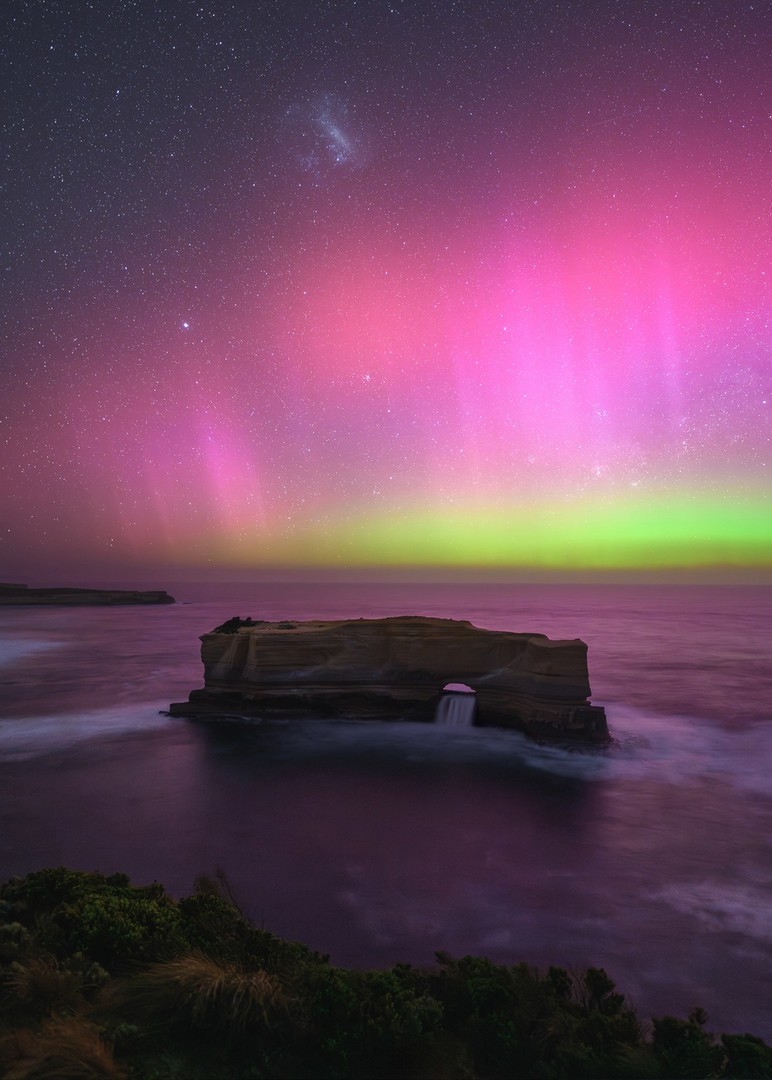
“Bakers Oven Aurora Australis” – Josh Beames
- Bakers Oven, Australia
I just recently noticed that the sun had emitted a massive solar flare which looked to be heading in Earth’s direction.
I kept an eye on the charts and was excited to see that it would be a direct hit, granting a great opportunity to capture the elusive Southern Lights!
As I checked the weather forecast, I saw we were going to have the perfect conditions, combined with the possibility of capturing a strong Aurora Australis. We made our way along the Great Ocean Road, to Bakers Oven, where were treated to an absolute show after sunset.
15 Sec, ISO 5000, f/1.8. Single frame
“Goleuadau’r Gogledd” – Mathew Browne
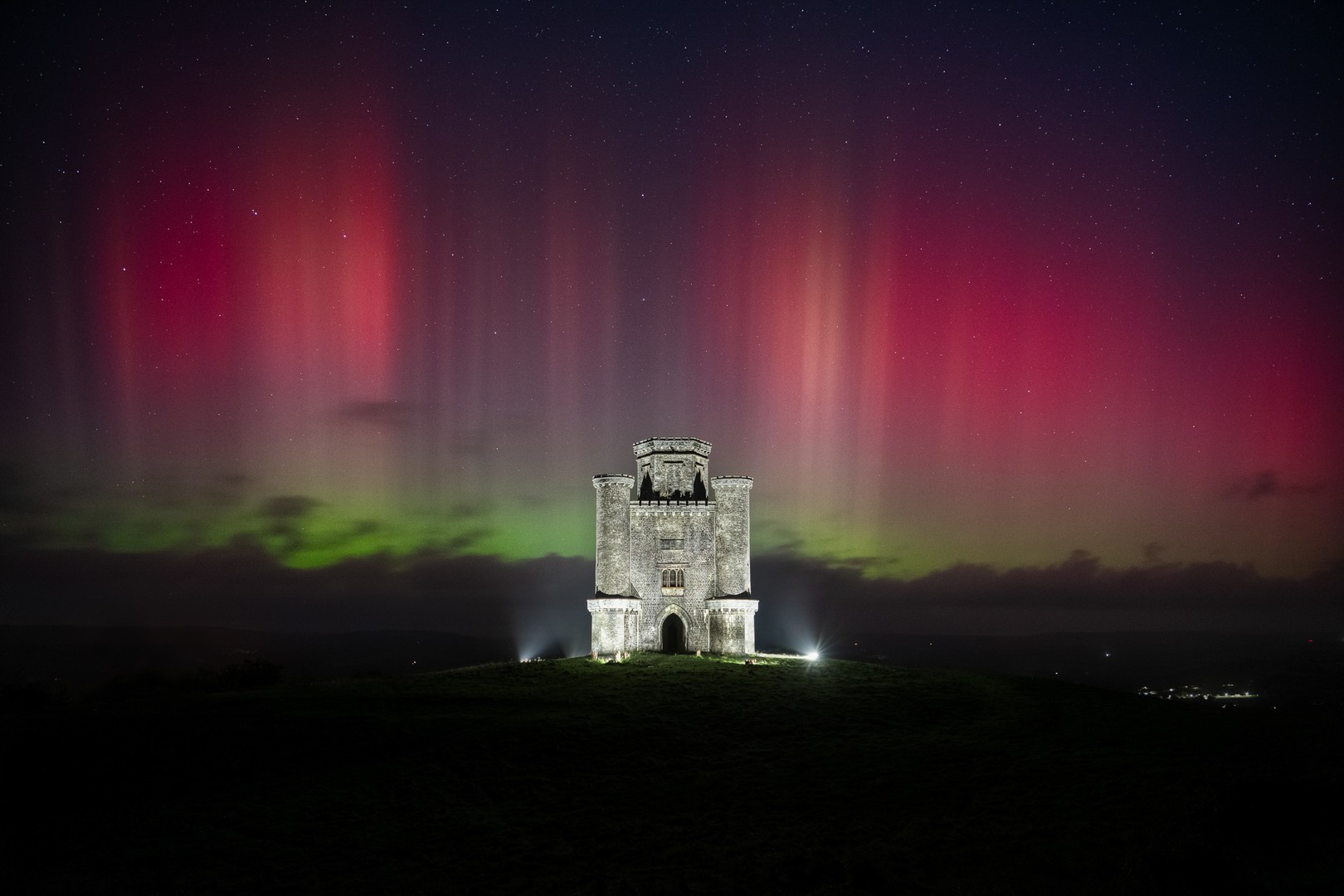
“Goleuadau’r Gogledd” – Mathew Browne
- Wales, United Kingdom
The title of this image, “Goleuadau’r Gogledd,” translates to ‘Northern Lights’ in Welsh. Finding the accurate translation proved challenging, as this phrase isn’t commonly used in everyday conversations here in South Wales.
Witnessing the aurora borealis this far south is a rare occurrence, and capturing it at an iconic location like Paxton’s Tower adds to its uniqueness. Paxton’s Tower, a hilltop folly with a history spanning over 200 years, overlooks the picturesque Carmarthenshire countryside.
For over an hour, the horizon beyond the clouds emitted hues of green and pink. However, for a brief yet magical moment, the sky came alive with impressive pink pillars, visible to the naked eye.
28mm, f2.8, ISO 1600
Bracketed exposures at 1,4 and 8 seconds
“The Platform” – Virgil Reglioni
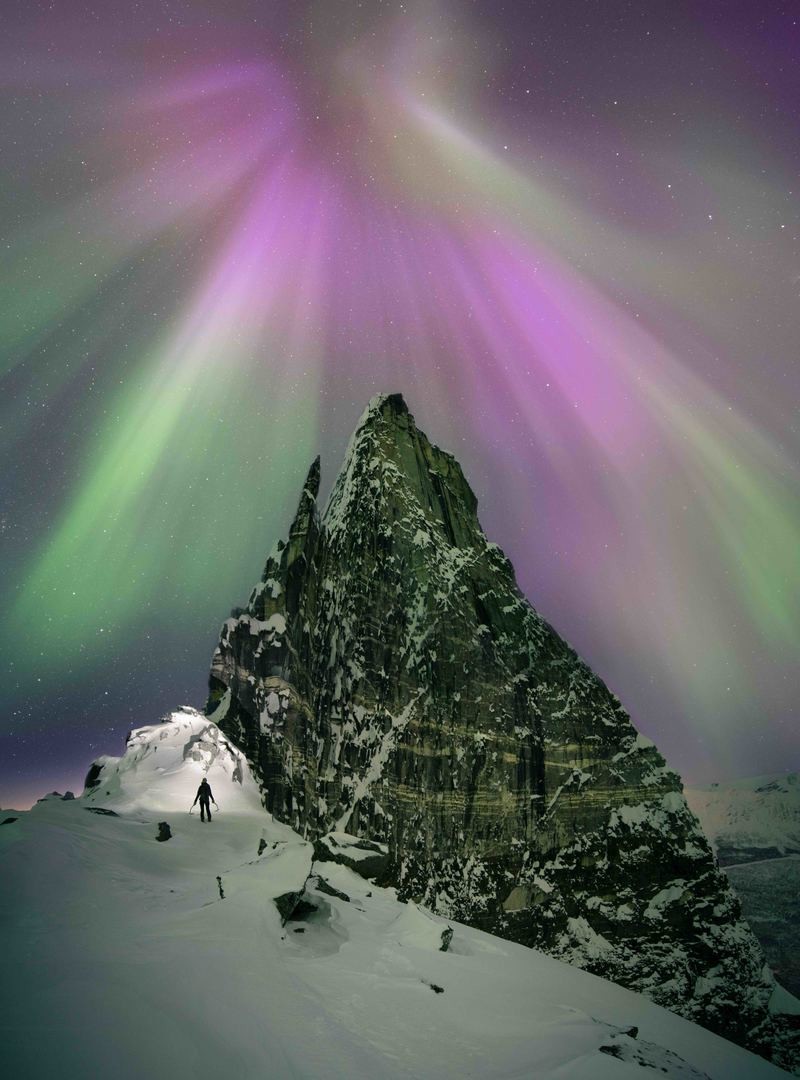
“The Platform” – Virgil Reglioni
- Otertinden, Norway
That day, March 23, 2023, Earth experienced the strongest geomagnetic storm in six years, and I was out executing my unique aurora shot of the year, “The Platform.” Both Maria and I had significant doubts about this climb. While we unintentionally chose one of the best aurora night displays in years for this mission, this accounted for only 10% of the work for “The Platform” image to come to fruition.
We started the ascent of this 47° steep snowy slope during the blue hour, enduring -21°C temperatures, while the Northern Lights lit up the Southern sky.
After overcoming the steepest part, Maria, ahead of me, spotted the tip of the cliff and exclaimed, “I see the cliff! I see the cliff!” I’ll remember the adrenaline kick it gave me for a while. All I could think was, “No way, we made it… now, how is the sky?”
Facing the cliff on the platform, the Aurora Borealis danced above us — jackpot.
Vertical Panorama each exposure is of 2 seconds to capture the maximum details into the light (F2.0 and 15mm)
“The Red Flame” – Laura Oppelt

“The Red Flame” – Laura Oppelt
- Wadden Sea National Parks, Germany
What a crazy night it was in Northern Germany on September 25th! It’s still hard to believe that I witnessed such a strong aurora show this far South from the polar circle. It began with a faint glow on the horizon around 10 PM and intensified over time. The live view of my camera displayed the greens quite well, though they weren’t visible to the naked eye.
Later, as the reds and pinkish/purple tones emerged, the colors became clearly visible to the human eye. At a certain point, everything in the sky seemed to explode, and I couldn’t help but scream out loudly on the beach in pure excitement and disbelief!
Experiencing such an intense show in Germany was truly awesome. I’m still astonished while writing down these words, and I’m grateful to have witnessed this special event in my home country on a small island in the North Sea. The photograph’s composition might not be original, and the horizon is illuminated by lots of ships anchoring nearby overnight, but the clearly visible aurora makes this image special and meaningful to me.
“Waning Sun” – Alex Wides
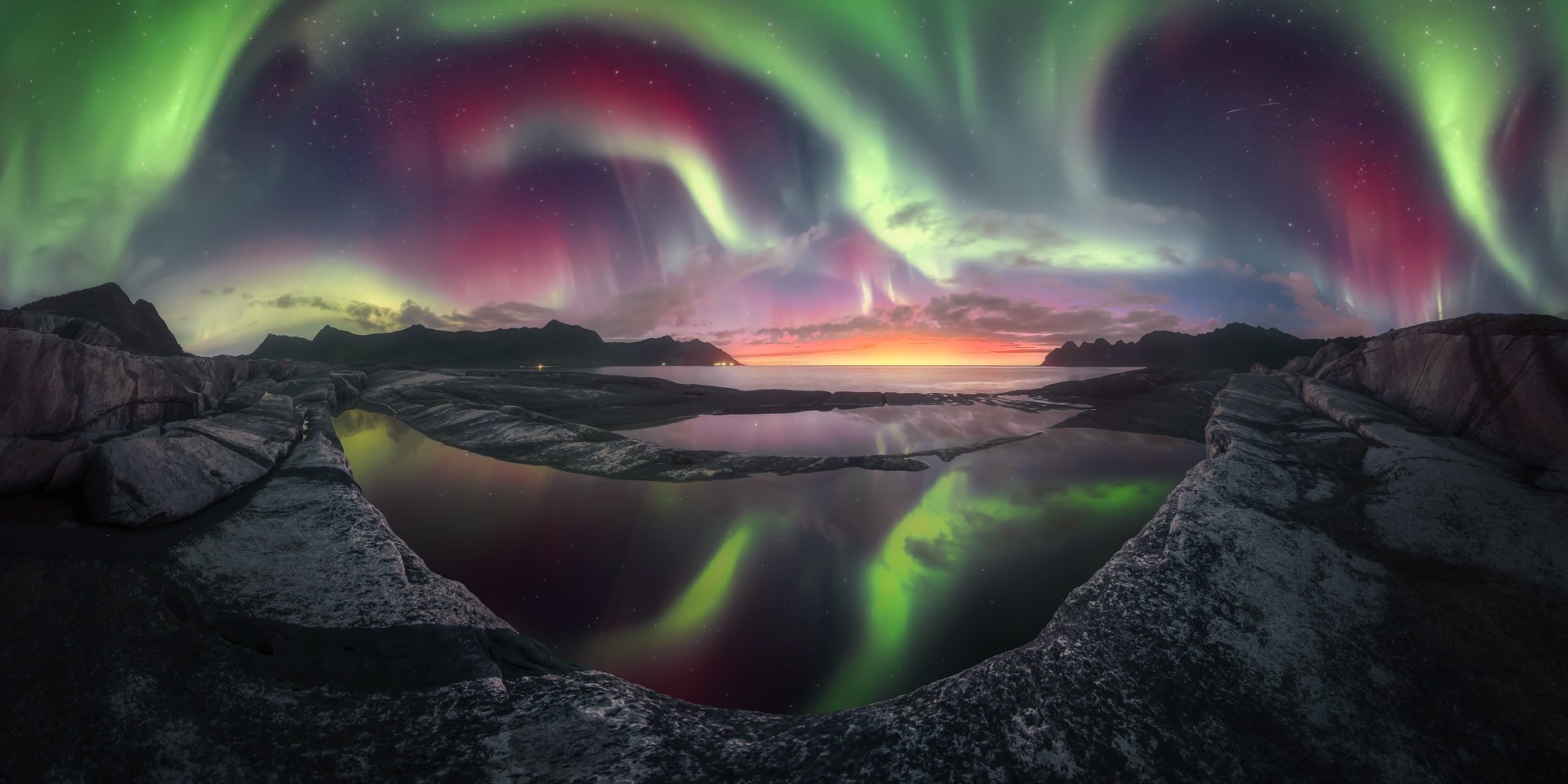
“Waning Sun” – Alex Wides
- Senja Island, Norway
A 300° panorama captured on Senja Island (Norway) featuring the setting sun and an intense kp7 Northern Lights display.
Embarking on a three-month journey from Italy to the Great North, you anticipate witnessing incredible sights, but this trip surpassed all my expectations. Arriving at Senja Island, my personal favorite among the places I’ve been fortunate enough to visit, we encountered the most powerful Northern Lights of the year, exactly as predicted.
The horizon is glowing with the light of the setting sun; in September, it sets at 11:00 PM, painting the sky in vibrant shades of green, purple, and red. This shot encapsulates the essence of the journey, capturing the beauty of an extraordinary adventure on one unforgettable evening with my family and two dogs, witnessing an awe-inspiring spectacle.
GET YOUR FREE EBOOK!
– PHOTOGRAPHING THE NORTHERN LIGHTS –
BEST SETTINGS, GEAR, PLANNING, TIPS, AND MORE!
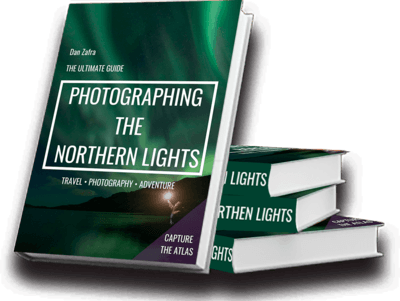
“Lady in Pink” – Kenneth LeRose
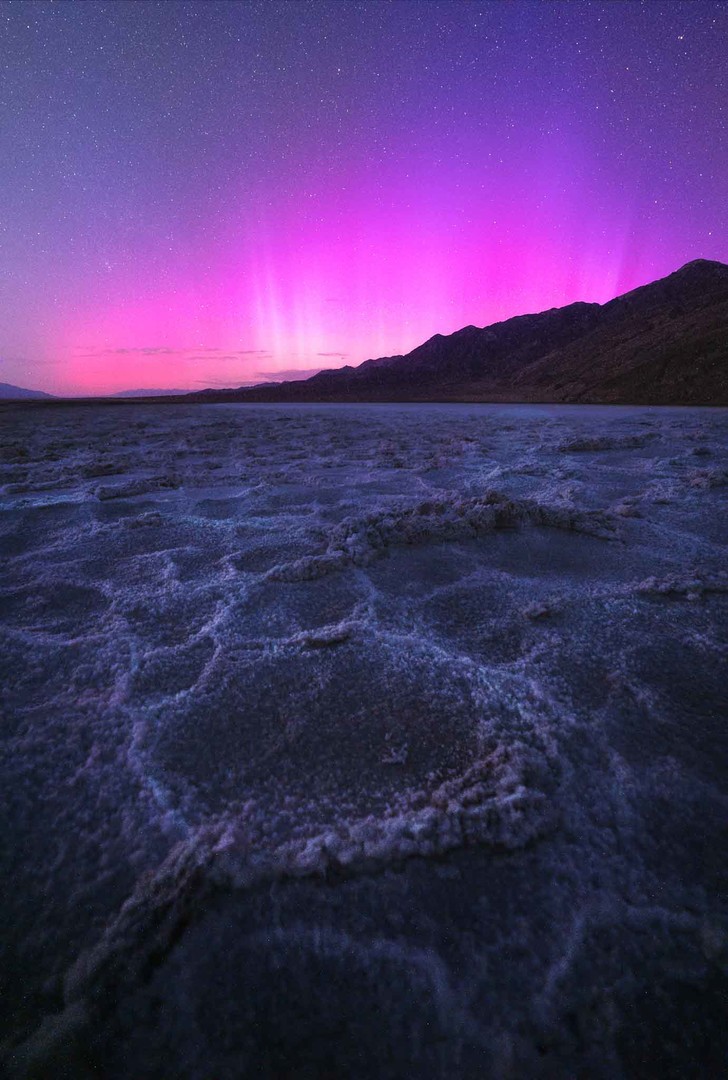
“Lady in Pink” – Kenneth LeRose
- Death Valley, USA
I really didn’t believe I’d see the aurora at the lowest altitude point in the US. When I saw the aurora forecast, I was in Vegas. The decision to drive to Badwater Basin was a last-minute one.
When I arrived, I started to second-guess myself once I saw all the atmospheric particles sinking into the basin. I kept thinking about changing locations because it wasn’t looking promising.
I parked just before blue hour and gathered a tripod and camera. I didn’t even take my camera bag out. I thought there would be no need to carry my second camera and tripod, but as I got halfway to my destination, I started seeing some faint lights in the sky. I couldn’t believe my eyes. I stopped and took a test shot and there it was! Pink pillars in the sky! I started running to find a composition to set up a timelapse. I ran back to my airstream a mile behind me to get the rest of my gear. I started snapping stills and set up another timelapse. This was my favorite still frame taken from this memorable night.
In true fashion, I write poems for each image I publish on socials. Heres the poem I wrote for this on:
Read the Poem (Click to display)
“Drenched with ambition.
Flowing desire.
Lady in pink.
Internalized fire.
Against all the odds.
She carries my light.
When I’m down for the count.
She reminds me to fight.
She lessens the blows.
Her beauty’s unmatched.
She’s fire to the night.
She’s the spark to my match.”
ISO 6400 ~ F/2.8 ~ 15 Secs
“Island of Aurora” – Kat Lawman
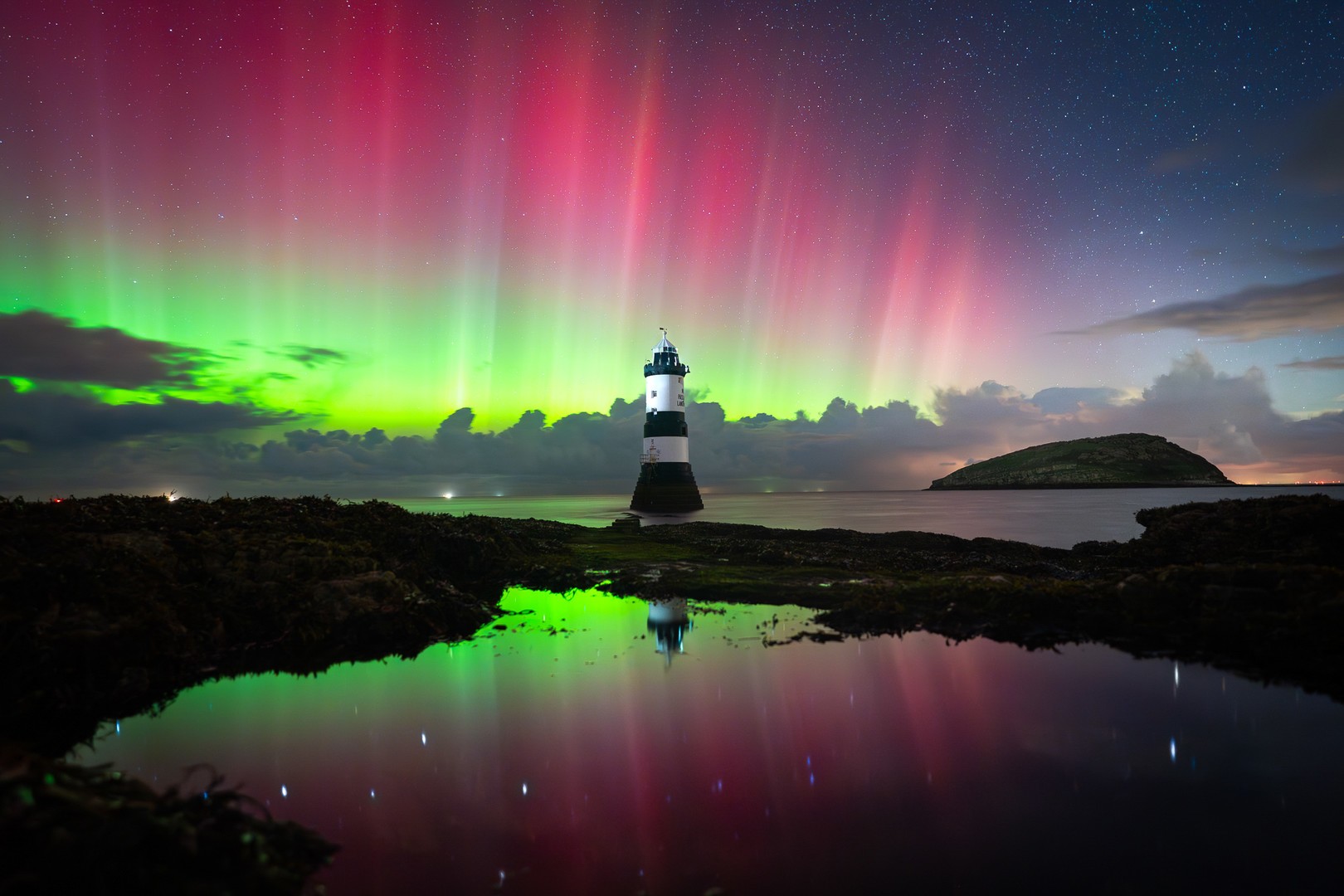
“Island of Aurora” – Kat Lawman
- Wales, United Kingdom
I was fortunate enough to capture the Northern Lights from Northern Sweden back in March, with beautiful visible green waves overhead. However, I never expected to capture an incredible Aurora like this just a 15-minute drive from my door.
Upon reaching the location, the aurora was exceptionally powerful. I worried that by the time I had sorted all my equipment and scouted my composition, I might miss the main show. Nevertheless, I set up my tripod next to a small pool of seawater, focusing on capturing reflections. At this point, the aurora had slightly diminished, and I had to endure a few rain showers. However, my efforts and perseverance paid off around 9:30 pm when huge green and pink light pillars shot out of the sky—completely mesmerizing!
Single shot ISO3200 F2.2 10 Seconds at 20mm
“Aurora Explosion” – Jason Perry
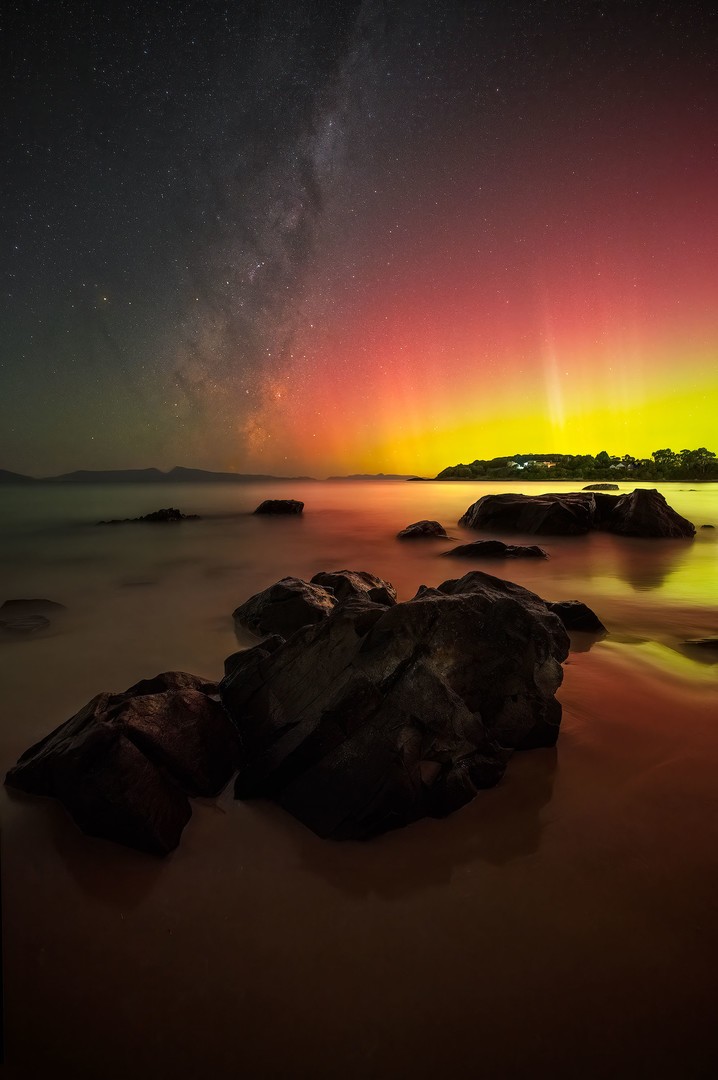
“Aurora Explosion” – Jason Perry
- Tasmania, Australia
Taken in Tasmania back in April 2023, the Southern Lights displayed their strongest presence in a long time. The celestial show commenced right after dark, coinciding with the emergence of the Milky Way core. This is undeniably a convergence of people and space.
The house lights on the right side, closest to me, contrast with the mountains of Freycinet National Park across the bay. I positioned myself as close as possible to the rocks, where the rising tide caused water to swirl around them. Despite having to reset the tripod a few times, the resulting reflection made the effort worthwhile.
Stacked/blend, All shots were 13 seconds at f/2.8, ISO 5000. I stacked the foreground with 12 shots and used a single exposure for the sky so I wouldn’t lose detail in the aurora.
“Gatklettur Northen Lights” – Stefano Pellegrini
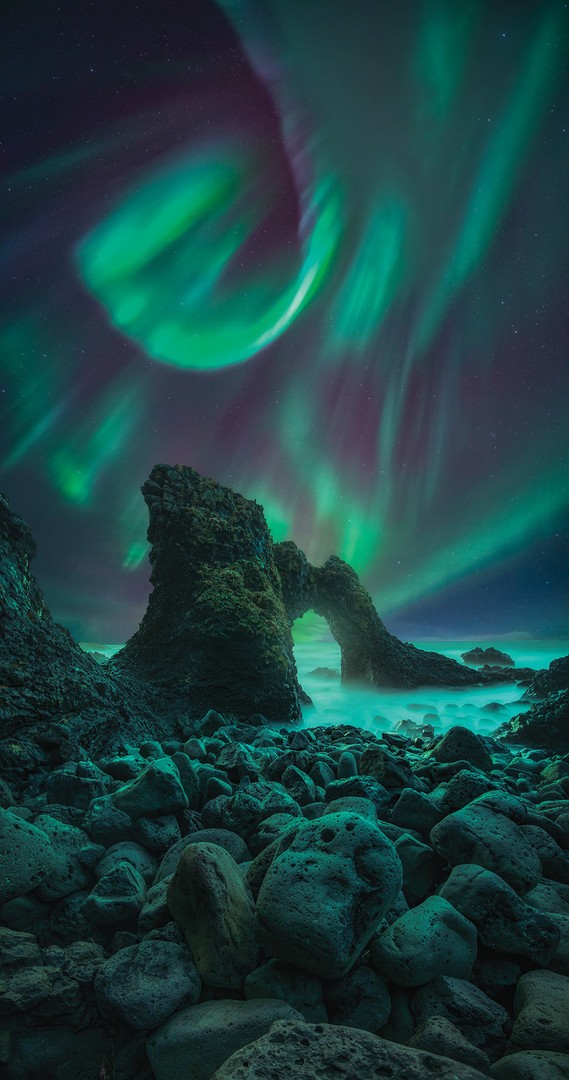
“Gatklettur Northen Lights” – Stefano Pellegrini
- Gatklettur, Iceland
I spent a week in Iceland, chasing the Northern Lights. Opting for total freedom of movement to track clear skies each night, I lived in a car, planning my itinerary day by day instead of booking hotels in advance. The strategy paid off, and I captured the aurora on four out of seven nights. This photo is from the first night.
Arriving at the location after dark, I parked the car and prepared my sleeping bag. Despite being up since 4 AM, I set my alarm clock to wake me every hour in anticipation of a KP5 forecast for the night. I woke up at 2:30 am on my own and spotted green hues from the car window. I hurried out, shooting frantically to seize the opportunity.
The final image is my second attempt. Initially, I framed the arch from the front down on the rocky shore but I wasn’t satisfied with the result. After a night of running around various locations, at 5 AM in the morning, I returned to the beach for another composition.
The final image is a pano of 5 horizontal shots. The foreground is a focustaking at 2 minutes f5 ISO 2000, the sky was made at f2.8 ISO 5000 5sec.
“Beauty of the North” – Elena Ermolina
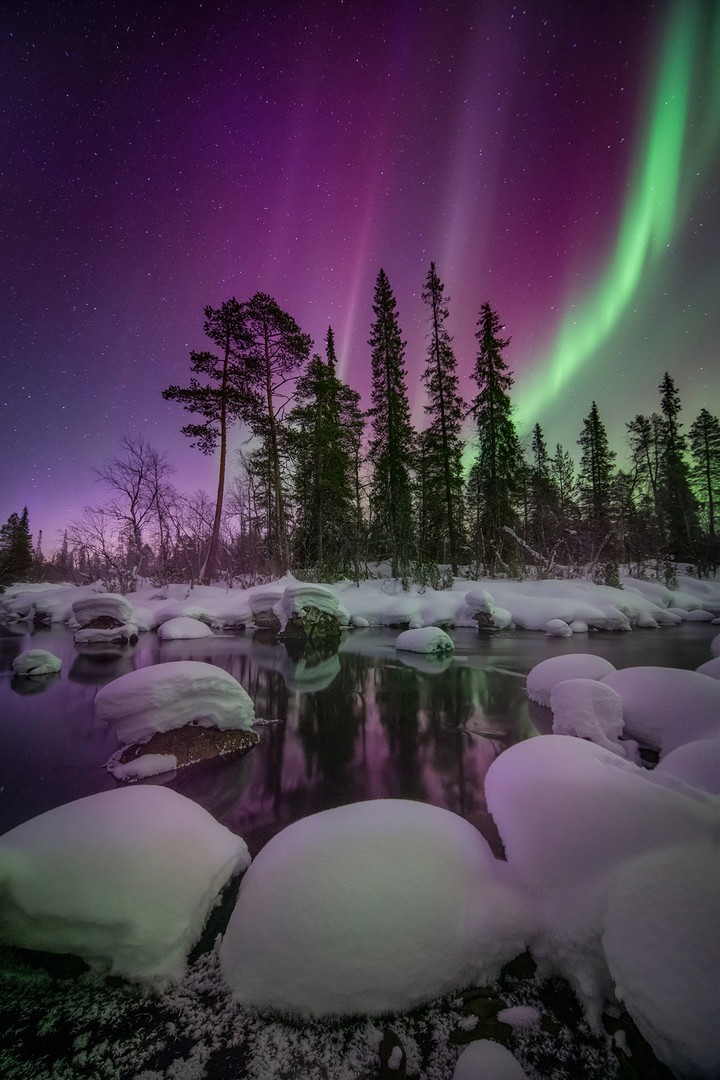
“Beauty of the North” – Elena Ermolina
- Kola Peninsula, Russia
On that beautiful night, the sky was painted green by the Northern Lights and their ethereal dance.
The Aurora was casting an incredible glow over the natural elements in the landscape. In this breathtaking moment, I managed to capture the celestial spectacle with my camera, which revealed even more colors than my eyes could see.
“March Michigan Nights” – Justin Miller
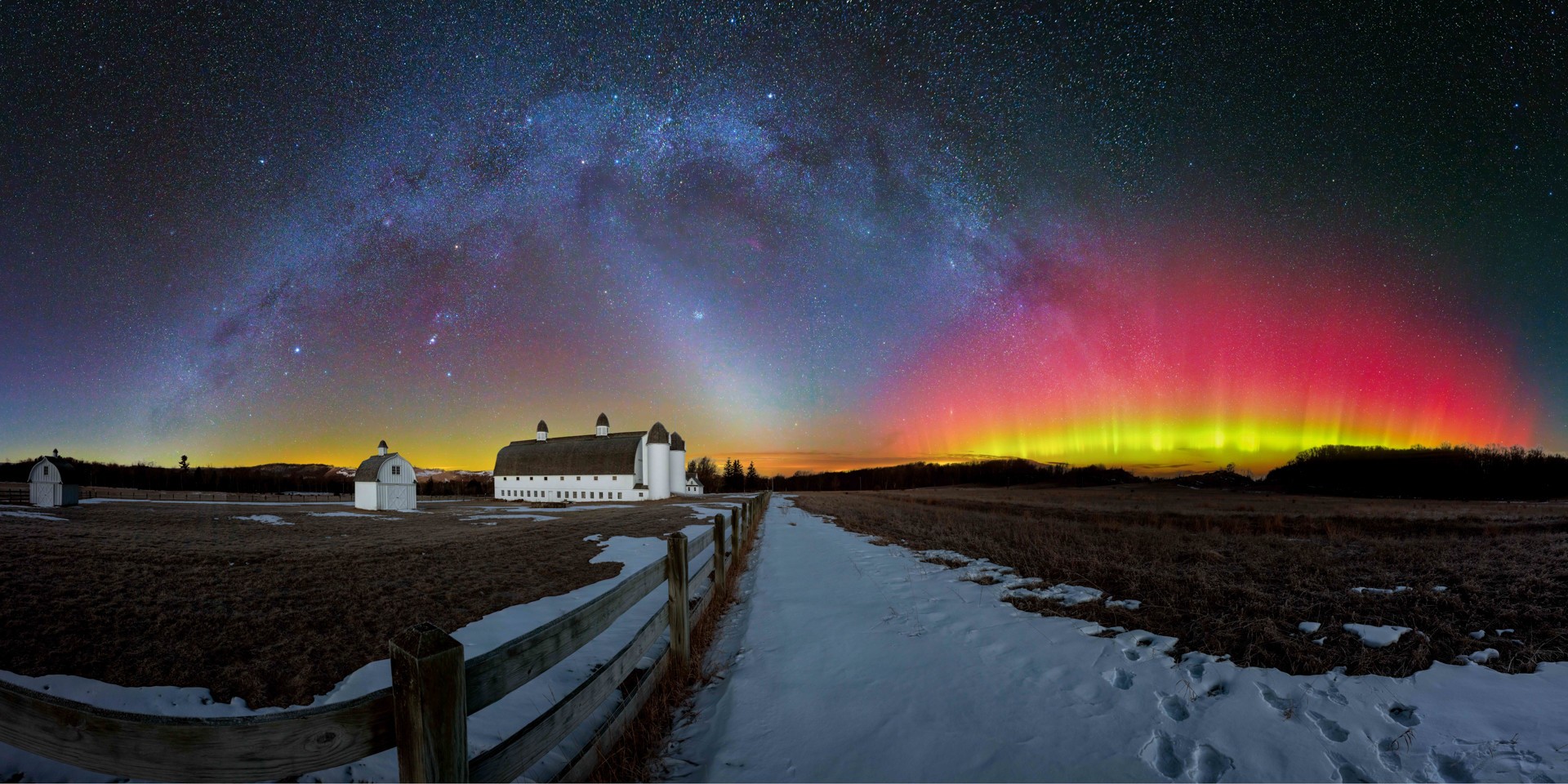
“March Michigan Nights” – Justin Miller
- Glen Arbor, Michigan
Heading to this area in my home state in Michigan, I noticed a new G1 Aurora watch for the night. To secure the best lookout for the sky, I climbed a nearby sand dune just up the road from the barn. The aurora exhibited a nice glow right after dark, but had no movement. After completing the bottom two rows, it began to slowly dance with tall pillars moving across the sky! I took a short break to capture this non-tracked version, seizing the tall pillars with a shorter exposure.
I completed this version, continued to finish the tracked version, and ended the night with a timelapse by the barn until I took the blue hour foreground shots the following morning. It was a spectacular night!
4-row panorama
Sky: 3 rows, 12 images per row
ISO 6400, F2, 8 seconds
Foreground: 16 images
Blue hour blend
ISO 800, F14, 8sec
“Fleeting Moments on Ice” – MaryBeth Kiczenski
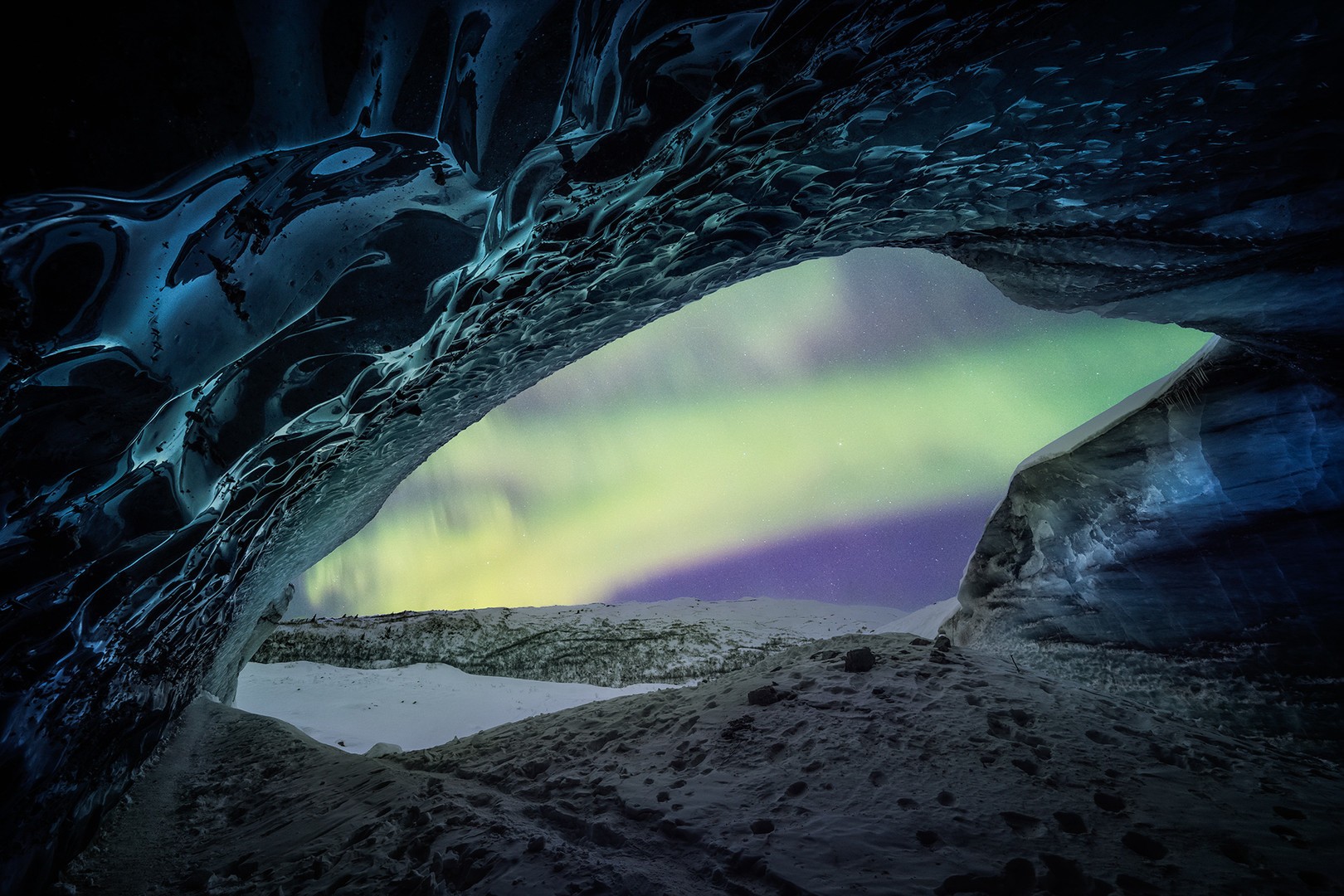
“Fleeting Moments on Ice” – MaryBeth Kiczenski
- Alaska, USA
Hiking under the Northern Lights is an experience I’ll never forget. Witnessing the Aurora from an ice cave is even more unforgettable! Both experiences are fleeting but for different reasons.
The aurora comes and goes as the solar wind blows, while ice caves emerge and disappear as the planet undergoes heating and cooling cycles. This specific ice cave, especially the ice arch featured in this photograph, collapsed over the summer. Knowing its days were numbered, I prioritized a visit in March of this year.
Consequently, this image holds extra significance for me, capturing those ephemeral moments and serving as a reminder not to take things for granted.
This is a blue hour and focus stacked blend to capture the details of the ice.
Cave – ISO 800, 1-second, F/11
Sky – ISO 3200, 4-seconds, F/2.8
14MM (both)
“Green Snakes” – Filip Hrebenda
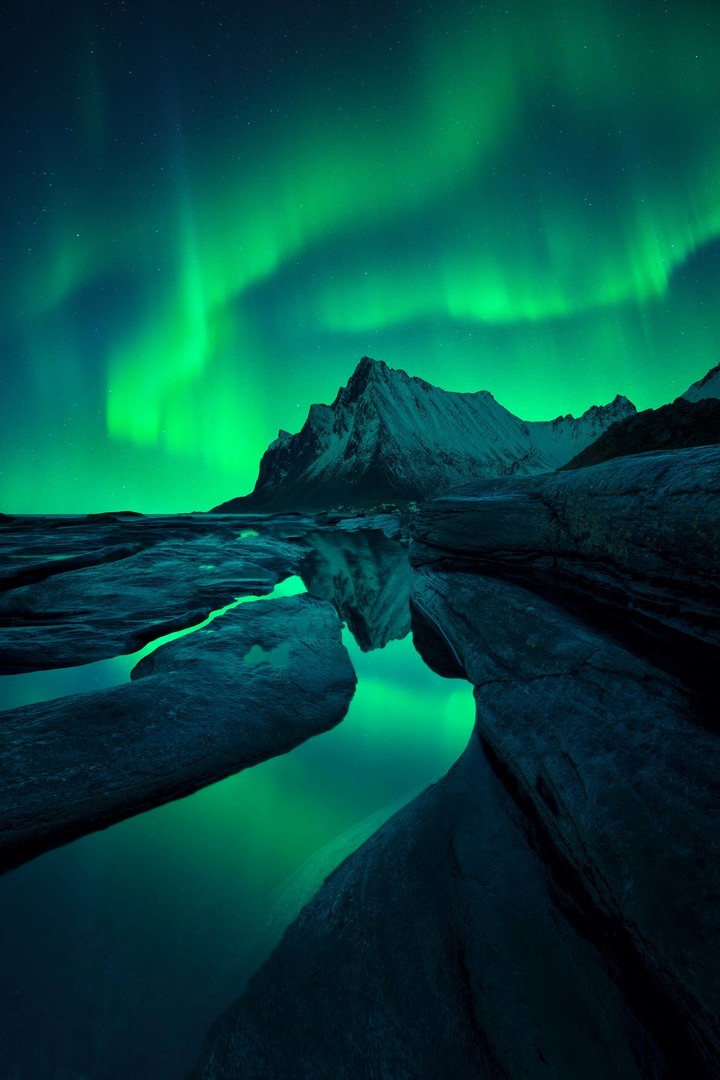
“Green Snakes” – Filip Hrebenda
- Vikten, Norway
This photo was taken at one of the lesser-known beaches in Lofoten, Norway, called “Vikten.” As with my other shots, I aimed to capture something new and different. During low tide at Vikten beach, numerous small pools emerge in the rocky paths carved by the ocean. So the first crucial step was to wait for the low tide.
Then, I sought the ideal composition with a foreground pool to create a leading-line effect. After a few minutes of searching, I found it! The next challenge was achieving sharpness, which can be challenging in low light conditions. To address this, I needed to focus stack the foreground. I used six individual shots for focus stacking the foreground to ensure everything was sharp.
Following that, I had to wait for the ideal aurora shape to improve my composition. I captured several photos and selected the one in which it formed the ideal shape for my composition. This allowed the aurora itself to become a part of the leading lines, resembling “green snakes”.
Foreground: 15 sec., f/4, ISO 4000 (6 focus stacking shots)
Aurora: 4 sec., f/2.8, ISO 3200
“Northern Lights in Nova Scotia” – Kristine Rose
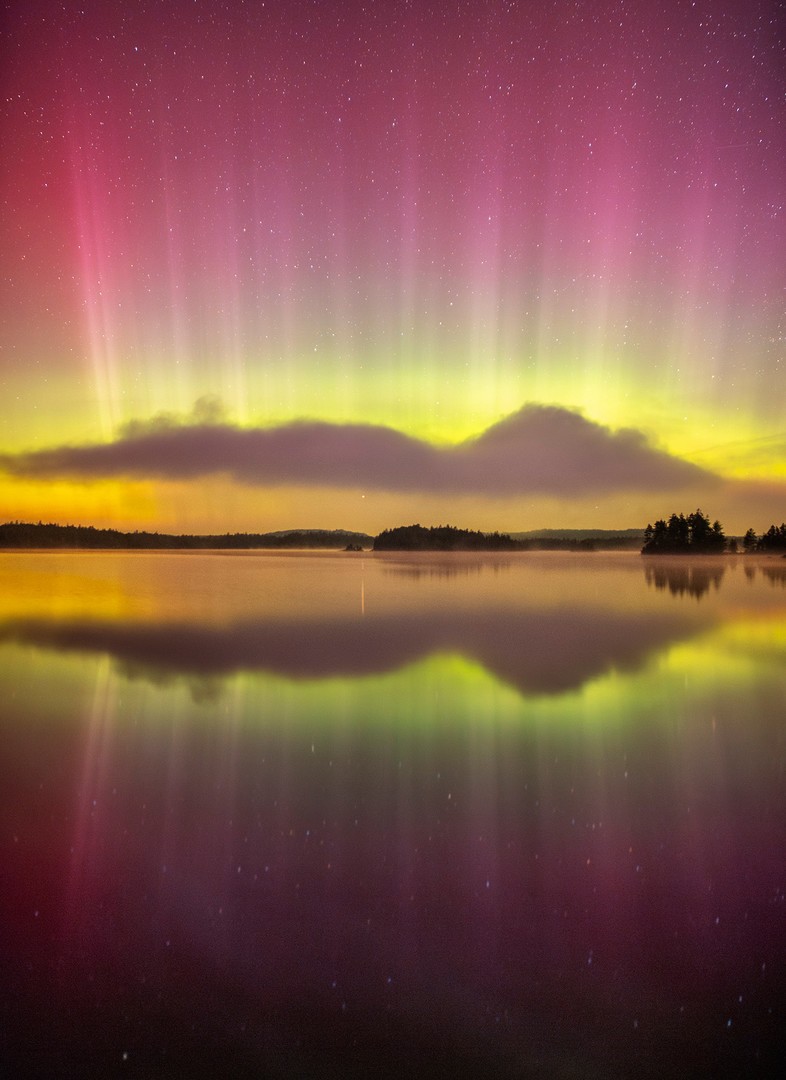
“Northern Lights in Nova Scotia” – Kristine Rose
- Nova Scotia, Canada
I had no plans to go out and shoot this night. I spent the entirety of the previous day flying back from a trip west where I was shooting the Milky Way every night. I was feeling jet-lagged and had to be up early with my kids the next day.
However, when I looked outside and saw a break in the clouds and the lights from my front step, I knew I had to go. It’s rare in Nova Scotia to get a solar storm and clear skies. And what a storm this was! A strong G4 geomagnetic storm lit the skies across North America, putting on the best show I’ve ever seen here in NS.
I drove 15 minutes to a north-facing dock, set up my cameras, and sat watching the show. I couldn’t be sure what exactly I captured since walking on the dock introduced camera shake to my images. Even though I had to get my kids up in 4 hours, when I got home, I immediately downloaded the images to look through, and may have done a silent happy dance in my kitchen at 3 AM upon seeing this one.
“Circle of Life” – Frøydis Dalheim
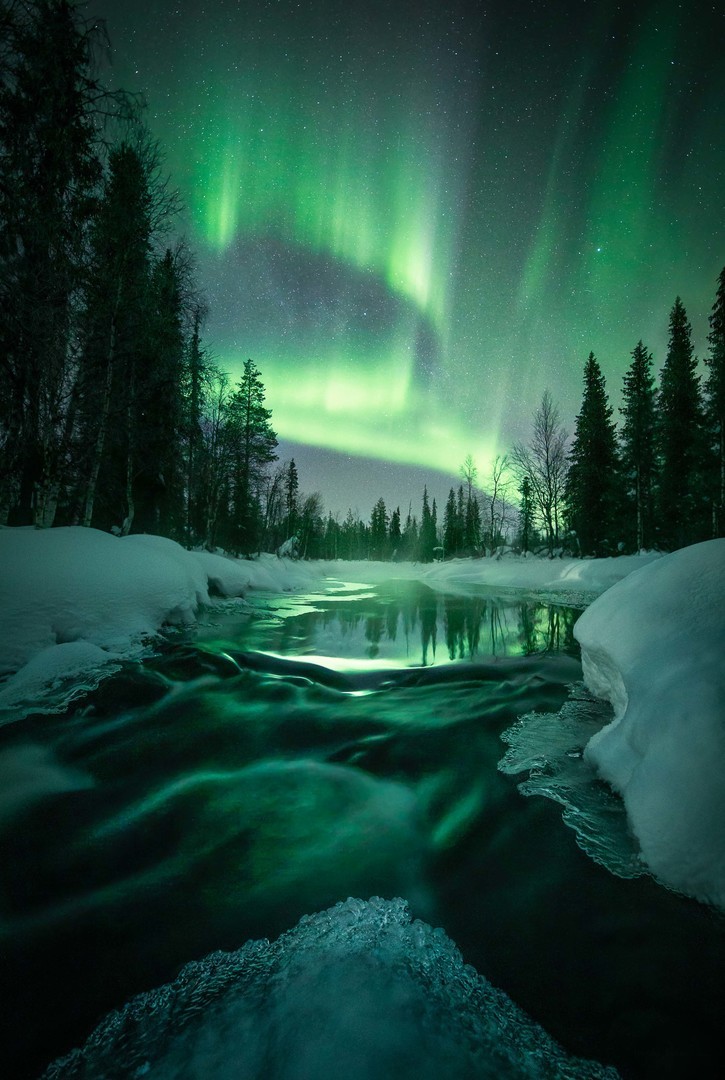
“Circle of Life” – Frøydis Dalheim
- Lappland, Finland
This is a magical place in the forests of the Finnish Lapland that I was fortunate to capture during an evening in late March.
A pair of swans were further down the river, and occasionally I could hear them singing. Even though it was freezing cold, at almost -30° Celsius, I enjoyed being embraced by the peace and harmony of this beautiful night!
14mm, ƒ/1.8, 10s, ISO 4000
“Aurora Flame” – Richard Zheng
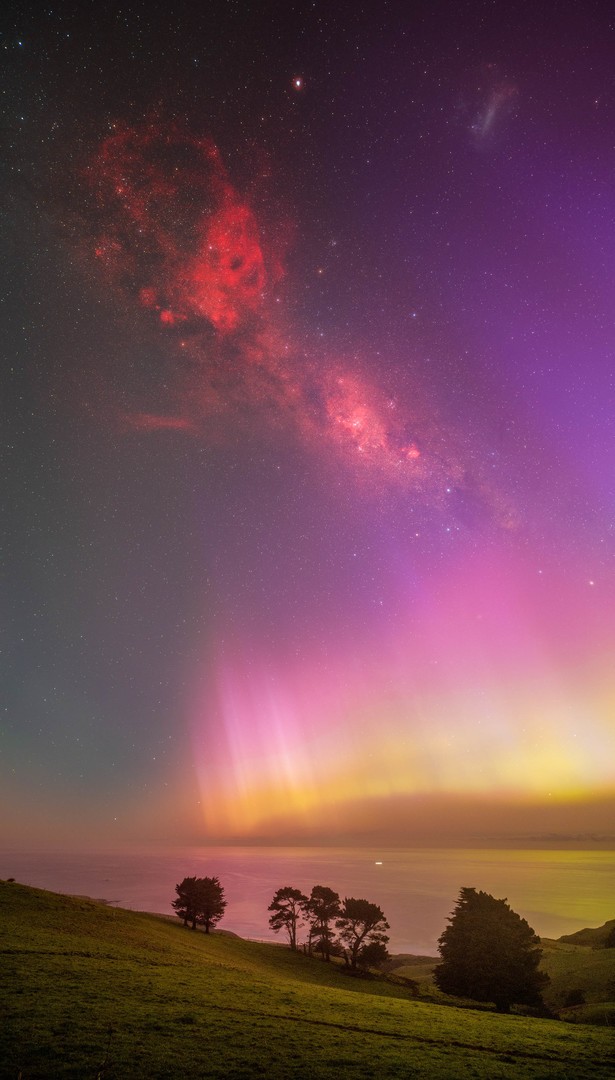
“Aurora Flame” – Richard Zheng
- Dunedin Peninsula, New Zealand
The peninsula of Dunedin in New Zealand is a good place to observe the aurora. It not only has very little light pollution but there are many bays facing South, which is ideal to capture the Aurora Australis. This photo was taken at an lookout on the roadside of Highcliffe.
This was the first time I had the opportunity to take photos of the Aurora and emission nebulae using a special camera for astrophotography.
In this photo, you can see the Large Magellanic Cloud in the upper right corner. The red mass in the upper left corner of the picture is the Colloidal Nebula, and extending down is the Carina Nebula.
Sky:
RGB: ISO500/F1.8/30″ * 10
H-alpha: ISO6400/F1.8/30″ * 10
Foreground: ISO1250/F1.8/30″
- Sony A7RIV Astromodified
- Viltrox 16mm f/1.8
- Move Shoot Moove Star Tracker
“The dance of the green lady” – Luis Cajete

“The dance of the green lady” – Luis Cajete
- Haifoss, Iceland
Witnessing a great Northern Lights display is an absolutely stunning experience. I took this picture at a beautiful waterfall in Iceland called Haifoss. The strong wind made photography challenging.
After an almost cloudless sunset, we took refuge in our camper van to rest and have a warm meal. Despite the forecasts not indicating significant solar activity, we decided to wait until nightfall and try our luck. We couldn’t pass up the opportunity to have this impressive place all to ourselves.
When we saw the first green lights through the window, we jumped outside. The sky exploded above us; the Northern Lights moved swiftly, and the strong wind continued to put us to the test.
At the peak of activity, I focused on securing the camera settings, and that’s when I began to enjoy the show, always mindful of not making a misstep and gripping the tripod tightly.
It was a dream come true to witness such incredible Northern Lights in a place like this.
Two row panorama: 3 photos per row
Foreground: 24 mm-f/2.8-Iso 6400-30 seconds
Sky: 24 mm-f/2.8-Iso 6400-6 seconds
“Blåvatnet” – Lukas Moesch
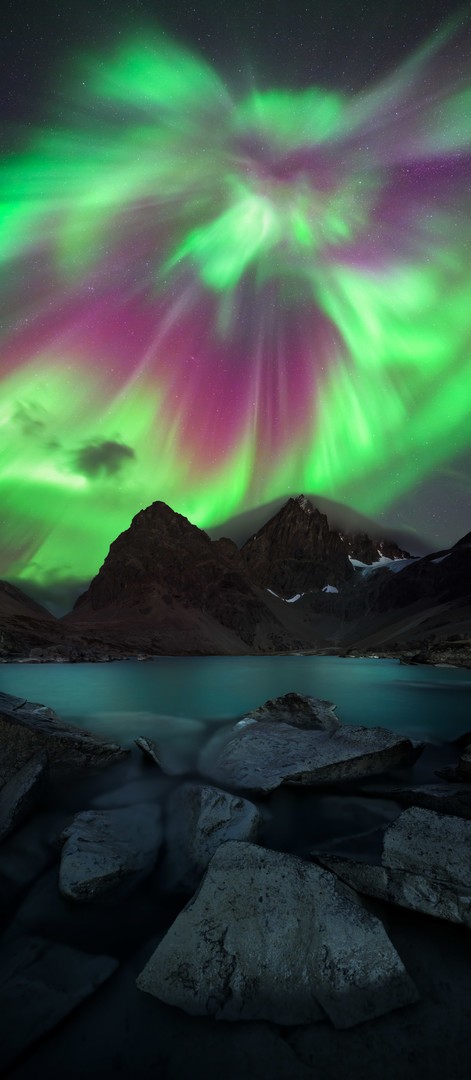
“Blåvatnet” – Lukas Moesch
- Tromso, Norway
On the way to the location where I took this photograph, I had a magical encounter with a rare white reindeer – which is a sign of good luck.
Despite this good omen, I wasn’t entirely sure I could capture the Northern Lights that particular night. After waiting for several hours, I began to witness a very faint glow during blue hour. What happened after that was mind-blowing! The whole sky turned green, purple, and red. The show lasted the whole night, and my hike back was lit by the bright green sky.
Sky: 14mm F/2.8, 6sec., ISO 10’000
Foreground: Focus Stack out of 3 frames, 14mm, F/13, 30sec, ISO 500
“Echant” – Paul Wilson
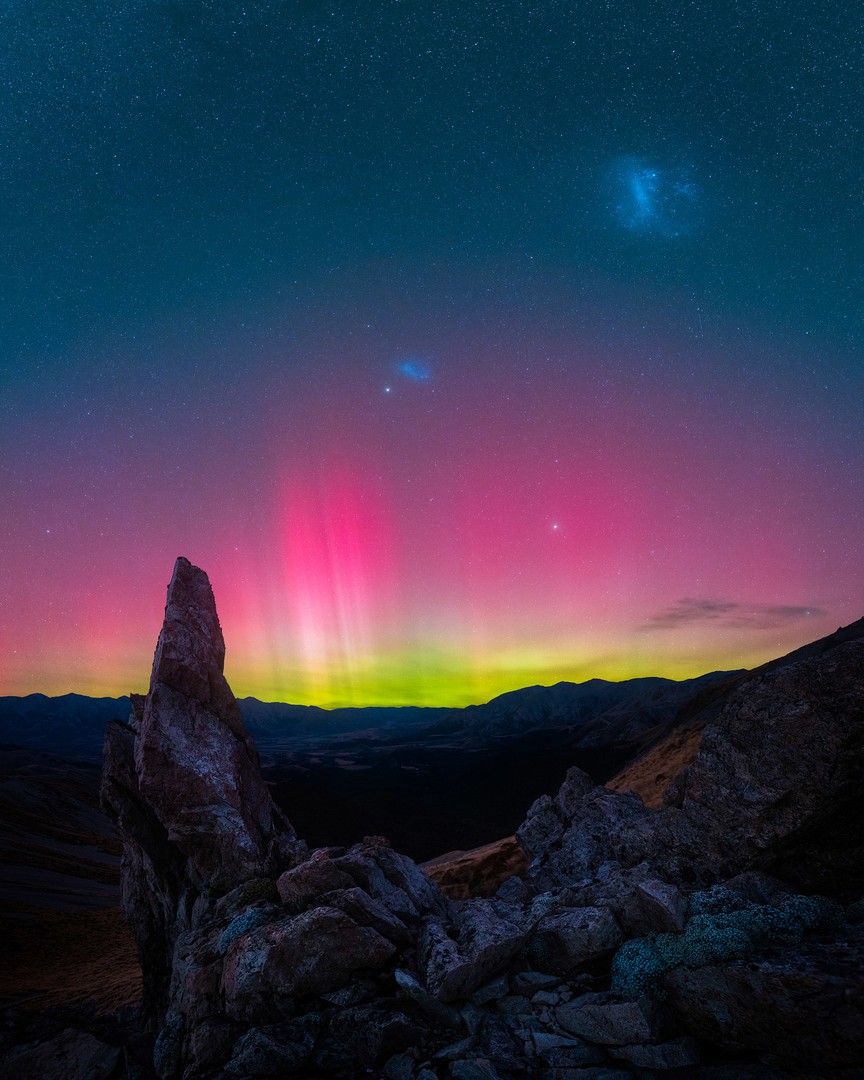
“Echant” – Paul Wilson
- Canterbury, New Zealand
The Aurora Australis from Camp Saddle in Canterbury, New Zealand.
After a challenging hike with 30 kg of equipment, I was delighted when the aurora made an appearance! The Large & Small Magellanic clouds can also be seen; these are galaxies visible only from the Southern Hemisphere.
Foreground – 14mm Sigma Art (focus stack of 4): 120s, ISO1600, f2.8
Sky – 28mm Sigma Art (4 shot panorama): 10s, ISO6400, f2.2
- Canon R5 Astromodified by Spencer’s Camera
- Sigma 14mm f/1.4
- Sigma 28mm f/1.4
“Kirkjufell Explosion” – Marc Marco Ripoll

“Kirkjufell Explosion” – Marc Marco Ripoll
- Kirkjufell, Iceland
This was our second night in Iceland, and the popular Mt. Kirkjufell was painted in green. With an aurora forecast in place, we stood there at dusk, anticipating the celestial display. As darkness descended, timid auroras emerged on the horizon.
Initially, I framed the classic view of the location, but suddenly, the sky exploded over my head! Faced with this spectacle, I mounted my wide-angle lens, aimed it towards the sky, and started shooting the first row of a panorama. As it wasn’t enough, I went for the second, then the third, and finally the fourth row!
The real challenge came when I tried to stitch it all together at home. Given the considerable movement in the Northern Lights, neither Lightroom nor Photoshop proved effective. In the end, I resorted to using control points in a specific panorama program, and it worked!
This is a 4-row panorama composed of 24 vertical images.
Each single image was taken at ISO 6400, 8s, f.2.8 and 14mm
I hope you found these images inspiring and that they encourage you to go out and have incredible adventures shooting the Northern Lights.
If you’re interested in photographing the aurora, some technical knowledge is key, and the best way to prepare your shots is by downloading our Northern Lights photography guide, which will help you capture the “green lady.”
GET YOUR FREE EBOOK!
– PHOTOGRAPHING THE NORTHERN LIGHTS –
BEST SETTINGS, GEAR, PLANNING, TIPS, AND MORE!

Also, don’t forget that camera gear for shooting the Aurora and the best settings in Northern Lights photography are important.
Thank you for sharing this article with others who might find it inspiring.
Below is a gallery with all the images at their full size. Enjoy it!
Please do not download, copy or share any of the photos here without the author’s prior written permission. Consider the photos here to be protected by copyright. If anyone uses any of the photographs we will take the required legal actions.






